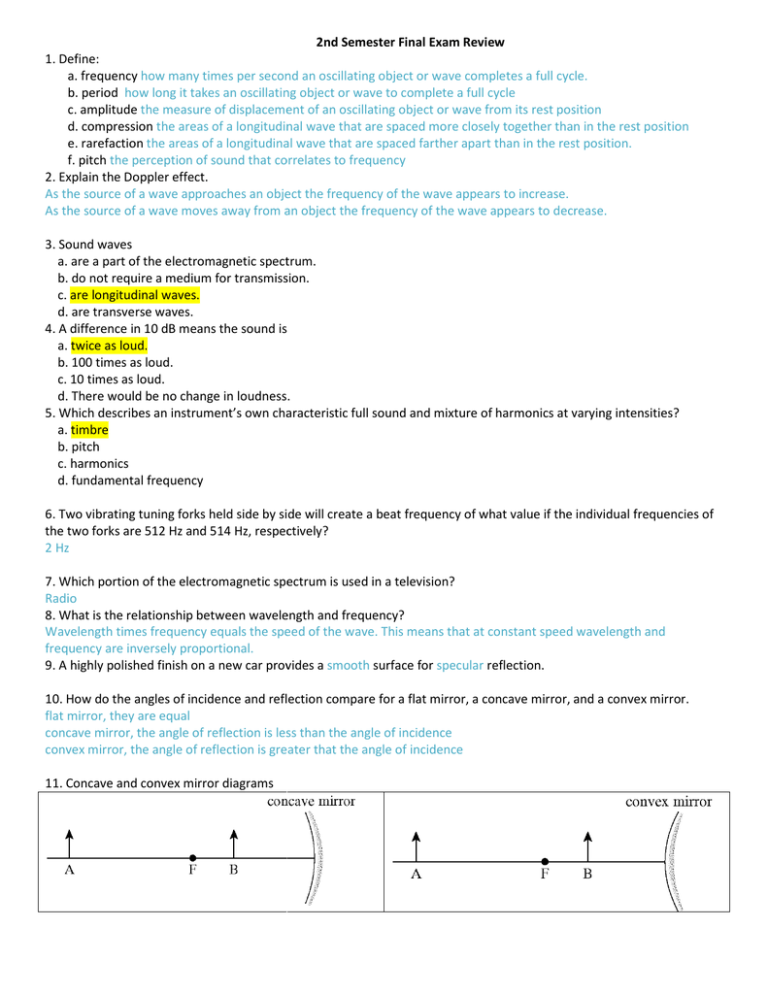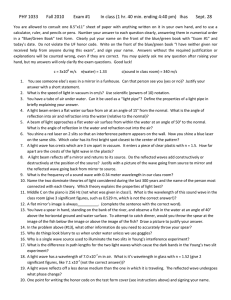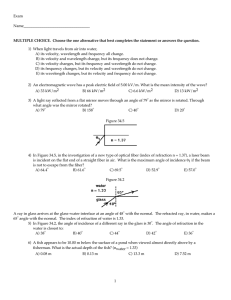1. Define: a. frequency how many times per second an oscillat b
advertisement

2nd Semester Final Exam Review 1. Define: a. frequency how many times per second an oscillating object or wave completes a full cycle. b. period how long it takes an oscillating object or wave to complete a full cycle c. amplitude the measure of displacement of an oscillating object or wave from its rest position d. compression the areas of a longitudinal wave that are spaced more closely together than in the rest position e. rarefaction the areas of a longitudinal wave that are spaced farther aapart part than in the rest position. f. pitch the perception of sound that correlates to frequency 2. Explain the Doppler effect. As the source of a wave approaches an object the frequency of the wave appears to increase. As the source of a wave moves away from om an object the frequency of the wave appears to decrease. 3. Sound waves a. are a part of the electromagnetic spectrum. b. do not require a medium for transmission. c. are longitudinal waves. d. are transverse waves. 4. A difference in 10 dB means the sound is a. twice as loud. b. 100 times as loud. c. 10 times as loud. d. There would be no change in loudness. 5. Which describes an instrument’s own characteristic full sound and mixture of harmonics at varying intensities? a. timbre b. pitch c. harmonics d. fundamental frequency 6. Two vibrating tuning forks held side by side will create a beat frequency of what value if the individual frequencies of the two forks are 512 Hz and 514 Hz, respec respectively? 2 Hz 7. Which portion of the electromagnetic spectrum is used in a television? Radio 8. What is the relationship between wavelength and frequency? Wavelength times frequency equals the speed of the wave. This means that at constant speed wavelength wavelengt and frequency are inversely proportional. 9. A highly polished finish on a new car provides a smooth surface for specular reflection. 10. How do the angles of incidence and reflection compare for a flat mirror, a concave mirror, and a convex mirror. flat mirror, they are equal concave mirror, the angle of reflection is less than the angle of incidence convex mirror, the angle of reflection is greater that the angle of incidence 11. Concave and convex mirror diagrams 12. Describe the image reflected in a flat mirror. the image reflected in a flat mirror is upright and virtual 13. What are the 3 additive pigments? red, blue, and green 14. What are the 3 subtractive pigments? magenta, cyan, and yellow 15. Explain how polarized sunglasses work, and which orientation would be most advantageous to someone driving on a sunny day. The light waves we perceive can be rotated at any angle about their longitudinal axis. Polarized sunglasses consist of microscopic lines that admit light rotated at only a specific angle. Since most of the glare while driving is due to reflection from horizontal objects (ie the road and hood of the car) the most advantageous configuration would be vertical lines. 16. When two polarized lenses are aligned at 90° to one another, how much light will be transmitted? None. Light that had the good fortune of making it through the first could not be properly aligned to make it through the second. 17. Define refraction; use the example of a pencil in water as an example. refraction is the bending of light as it passes from one medium into another. A pencil appears bent when you see it half submerged in water because the light from the bottom half bends as it leaves the water, where as the top half is in air, so the light from there is unrefracted. 18. Which is NOT correct when describing the formation of rainbows? a. A rainbow is really spherical in nature. b. Sunlight is spread into a spectrum when it enters a spherical raindrop. c. Sunlight is internally reflected on the back side of a raindrop. d. The angle between the incident white light and the returning violet ray is 45°. 19. In a double-slit interference pattern the path length from one slit to the first dark fringe of a double-slit interference pattern is longer than the path length from the other slit to the fringe by exactly what value? Exactly one wavelength 20. Define coherent light. Light of only one wavelength. (actually a very narrow band of wavelengths) Like from a laser. 21. Two beams of coherent light are shining on the same sheet of white paper. When referring to the crests and troughs of such waves, where will darkness appear on the paper? Darkness will appear where destructive interference occurs, so in locations where the crest of one wave aligns with the trough of another. 22. In terms of subatomic particles, what occurs when an object becomes negatively charged? Positively charged? When an object becomes negatively charged it has gained electrons. In order to become positively charged an object must lose electrons. The number of protons in an atom cannot change. 23. Define a. semiconductors a material that conducts electricity under certain conditions b. conductors a material that conducts electricity (or heat) well. c. insulators a material that does not conduct electricity (or heat). 24. A capacitor consists of two metal plates; ____ is stored on one plate and ____ is stored on the other. a. negative charge; positive charge c. potential difference; internal resistance b. potential energy; kinetic energy d. residual charge; induced charge 25. Increasing the separation of the two charged parallel plates of a capacitor when they are disconnected from a battery will produce what effect on the capacitor? The charge will remain constant. The capacitance of the capacitor, and the subsequent voltage it can generate, will both decrease. 26. What is the difference between alternating current and direct current? Alternating current changes direction several times per second, whereas direct current travels in only one direction. This means that the magnetic field about an alternating current carrying wire constantly fluctuates while around a direct current is constant. This allows us to build transformers for alternating current, but not for direct current. 27. What factors affect the resistance of a wire? What combination results in maximum resistance? What combination results in minimum resistance? Temperature, length, and cross sectional area. (The nature of the material itself factor in, but unless you are an omnipotent being you can’t change that) Max resistance is hot, long, and thin. Min resistance is cold, short and fat. 28. What do the power ratings on electrical devices (such as light bulbs)mean? Tells the rate at which electrical energy (the kinetic energy of electrons in a circuit) is transformed into other forms of energy such as light and heat. So a 20 W device transforms 1/5 the amount of energy per second as a 100W device. 29. Three resistors with values of 5 Ω, 8 Ω, and 16 Ω are connected in series. What is the equivalent resistance? 29 Ω. 30. Three resistors with values of 5 Ω, 8 Ω, and 16 Ω are connected in parallel. What is their equivalent resistance? 2.58 Ω 31. Where is the magnitude of the magnetic field around a permanent magnet greatest? The poles. 32. What is magnetic declination? Magnetic declination is the difference between true north, and magnetic north. 33. What 2 factors affect the strength of an electromagnet? The amount of current and the number of coils. 34.Describe the magnetic field about a current carrying wire. Imagine a wire traveling in and out of the screen. Current into the page Current out of the page This is the right hand rule for wires. 35. Describe the domains in a permanent magnet. Domains , tiny areas of magnetically aligned atoms, are aligned in a permanent magnet. 36. Electricity may be generated by rotating a loop of wire between the poles of a magnet. When is the induced current greatest? When the magnetic field and the loop of wire are perpendicular to one another. 37. According to Lenz’s law, the magnetic field of an induced current in a conductor will do what? It will always oppose the magnetic field that induced it. 38. What conversion process is the basic function of the electric generator? converting mechanical energy to electrical energy. 39. A step-up transformer used on a 220 V line has 195 turns on the primary and 3860 turns on the secondary. What is the potential difference across the secondary? 4355 V





